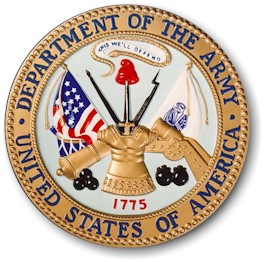
Department of the Army Emblem
Background: Prior to the establishment of the Department of the Army Emblem, there was no official display item to identify the Army. The Army seal traditionally had been used to authenticate documents only and was not authorized for display. In recognizing the need to provide a display item, The Secretary of the Army approved the design as the official emblem to represent the Army on 29 January 1974.
Description: The Army emblem is derived from the Army seal and differs from the seal in several respects:
a. The emblem is displayed in color while the seal is not.
b. The emblem includes the inscription, "Department of the Army," instead of the seal inscription, "War Office."
c. On the emblem, the American flag is on its own right (observers left) to reflect the current custom for display of flags. The Army flag pattern has been added to the other flag.
d. The Roman numerals "MDCCLXXVIII" which indicate the date the Army seal was adopted, were replaced with the date "1775" to reflect the date the Army was established.
Symbolism: The symbolism for the elements of the Army emblem is the same as for the Army seal with the above deviations and additions: The colors of the design elements are those traditionally associated with the ideals of the United States and of the Army. The flags are in proper colors. Blue is symbolic of loyalty, vigilance, perseverance and truth. Red denotes courage, zeal and fortitude. White alludes to deeds worth of remembrance. Black is indicative of determination and constancy. Gold represents achievement, dignity and honor.:
Description and Symbolism of the Army Seal:
Background: The traditional seal used during and since the Revolution was redesignated as the Seal of the Department of the Army by the National Security Act of 1947. The Department of the Army seal is authorized by Section 3011, Title 10, United States Code. The date "MDCCLXXVIII" and the designation "War Office" are indicative of the origin of the seal. The date (1778) refers to the year of its adoption. The term "War Office" used during the Revolution, and for many years afterward, was associated with the Headquarters of the Army.
Description: In the center is a Roman cuirass below a vertical unsheathed sword, point up, the pommel resting on the neck opening of the cuirass and a Phrygian cap supported on the sword point, all between, on the right an esponton and, on the left a musket with fixed bayonet crossed in saltire behind the cuirass and passing under the sword guard. To the right of the cuirass and esponton is a flag of unidentified designs with cords and tassels, on a flagstaff with spearhead, above a cannon barrel, the muzzle end slanting upward behind the cuirass, in front of the drum, with two drumsticks and the fly end of the flag draped over the drumhead; below, but partly in front of the cannon barrel, is a pile of three cannon balls. To the left of the cuirass and musket is a national color of the Revolutionary War period, with cords and tassels, on a flagstaff with spearhead, similarly arranged above a mortar on a carriage, the mortar facing inward and in front of the lower portion of the color and obscuring the lower part of it; below the mortar are two bomb shells placed side by side. Centered above the Phrygian cap is a rattlesnake holding in its mouth a scroll inscribed "This We'll Defend." Centered below the cuirass are the Roman numerals "MDCCLXXVIII."
Symbolism: The central element, the Roman cuirass, is a symbol of strength and defense. The sword, esponton (a type of half-pike formerly used by subordinate officers), musket, bayonet, cannon, cannon balls, mortar, and mortar bombs are representative of Army implements. The drum and drumsticks are symbols of public notification of the Army's purpose and intent to serve the nation and its people. The Phrygian cap (often called the Cap of Liberty) supported on the point of an unsheathed sword and the motto, "This We'll Defend," on a scroll held by the rattlesnake is a symbol depicted on some American colonial flags and signifies the Army's constant readiness to defend and preserve the United States.
Information provided by The Institute of Heraldry
page created 25 February 2000